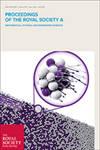关于Lennard-Jones EAM电位
Proceedings of the Royal Society of London. Series A. Mathematical and Physical Sciences
Pub Date : 2004-06-08
DOI:10.1098/rspa.2003.1190
引用次数: 14
摘要
我们基于嵌入原子方法的形式化描述了一个简单的双参数分析模型,该模型将短程Lennard-Jones势扩展到多体状态。我们证明,这是对真实材料的极简处理的第一步,可以忽略角力。该模型中的基态结构包含了所有的共相。在这个框架中,面心立方(FCC)材料的特性,如自由能、熔点、热膨胀系数、颗粒本文章由计算机程序翻译,如有差异,请以英文原文为准。
On the Lennard–Jones EAM potential
We describe a simple two–parameter analytic model, based on the embedded–atom–method formalism, that extends a short range Lennard–Jones potential into the many–body regime. We demonstrate that this is a first step toward a minimalist treatment of real materials with negligible angular forces. The ground–state structures in this model include all the common phases. In this framework, properties of a face–centred cubic (FCC) material such as temperature dependence of free energy, melting point, thermal expansion coefficients, Grüneisen parameters, elastic constants and defect properties are calculated as a function of the many–body parameters A and β. These properties are then expressed as analytic functions of A and β, as perturbations of the classical Lennard–Jones pair potential. Addition of the many–body effects to the classical Lennard–Jones pair potential brings the computed material properties to within the range of their experimental values for many FCC metals.
求助全文
通过发布文献求助,成功后即可免费获取论文全文。
去求助
来源期刊
自引率
0.00%
发文量
0
期刊介绍:
Proceedings A publishes articles across the chemical, computational, Earth, engineering, mathematical, and physical sciences. The articles published are high-quality, original, fundamental articles of interest to a wide range of scientists, and often have long citation half-lives. As well as established disciplines, we encourage emerging and interdisciplinary areas.

 求助内容:
求助内容: 应助结果提醒方式:
应助结果提醒方式:


